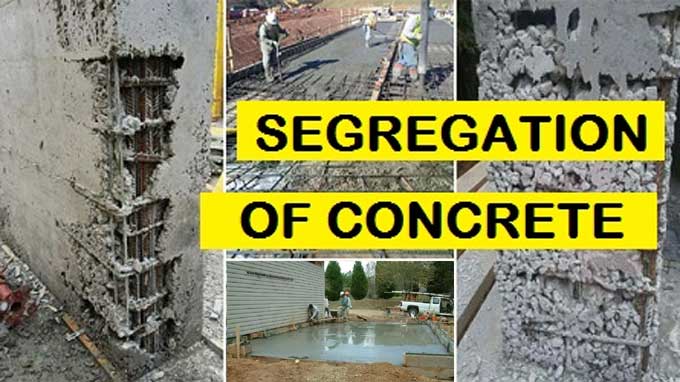
Concrete Segregation and Bleeding During Construction

Concrete is good when the constituent components are properly classified to form a homogenous mixture. Cement has a specific gravity ranging from 3.1 -3.6g/cc, which is the primary cause of segregation in concrete. Concrete sees aggregate segregation due to these differences in aggregate density, which lie between 2.6-2.7g/cc for aggregate.
Concreting operations only can identify the segregation of concrete, which cannot measure quantitatively during the process. Slump test separation can be estimated by evaluating the presence of concrete within the sample by evaluating the diffusion within a stream test.
Key Factors of Causing Segregation in Concrete
A. Long-distance transportation of concrete mixes.
B. Unbalanced mix. Insufficient matrix binds aggregates.
C. Concrete is dropped from a height of over 1 meter.
D. Long vibrations of concrete.
Minimizing Segregation in Concrete
A. The proportioning of the mix can control segregation.
B. Concrete is placed, transported, compacted, shaped, and finished in a peculiar way.
C. Segregation is controlled to some degree by adding air entraining agents, admixtures, and materials to the mix.
Types of Bleeding in concrete
There are three ways for concrete to be segregated.
1. Concrete bleeding results from the segregation of water over the top of the concrete.
2. The bottom or the corners of the formwork may segregate the coarse aggregates.
3. The cement paste segregates out of the concrete mix.
Bleeding in Concrete
A bleeding concrete mix occurs when the cement and aggregate settle, pulling the water upwards. Water has low specific gravity, and as a result, tends to rise. Wet concrete will usually bleed.
Water cement ratio is the primary reason for bleeding in concrete. High water-cement ratios result in weak concrete and excessive bleeding. When the rate of water evaporation and the rate of bleeding are equal, bleeding in concrete is not harmful. Concrete tends to be quite workable due to normal bleeding.
It may not be harmful to the concrete to bleed when it is fully plastic. In contrast, concrete remains in the plastic stage after it is compacted and subsidized.
It may not be harmful to the concrete to bleed when it is fully plastic. In contrast, concrete remains in the plastic stage after it is compacted and subsidized.
Bleeding Effects the stability of Concrete
1. When bleeding occurs, a certain amount of concrete is carried along by the water along with the bleeding. Having the top surface worked up with a trowel causes the aggregate to go down, and cement paste to form on the top surface. Because of Laitance in concrete, structures may become less durable.
2. Continuous channels are formed when water moves from the bottom to the top. This allows water to pass through the concrete and creates voids in the matrix which in turn weakens the bond between aggregate and cement paste.
3. Surface finishing of concrete is delayed by the formation of water at the top surface.
4. Permeability and homogeneity of concrete are compromised.
5. The concrete and reinforcement become loosened by excessive bleeding.
Controlling the Bleeding in Concrete
A. Minimum water content in the concrete mix is responsible for controlling bleeding in concrete.
B. Introducing air entraining admixtures to the mix.
C. Increase the cement content in the mix.
Conclusion
During the transition of plastic to stiffen state, segregation of concrete is all plays a role in causing bleeding in concrete. Concrete segregation is the separation of aggregates, pastes, and water from a homogeneous mixture of concrete.
The phenomenon of segregation of concrete arises when concrete is in a plastic state, which means that when concrete is freshly mixed, compacted, and placed, a state of transition occurs, which seriously affects the behavioral properties of concrete.
Concrete construction involves evenly coating coarse aggregate with sand and cement paste made from a homogeneous mass of good-quality concrete during handling, transportation, and placement. Concrete segregates during transit due to compression and vibration, which separates cement paste and sand from the coarse aggregate.
To learn more, watch the following video tutorial.
Engineering Motive


